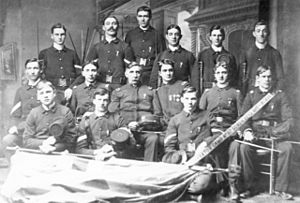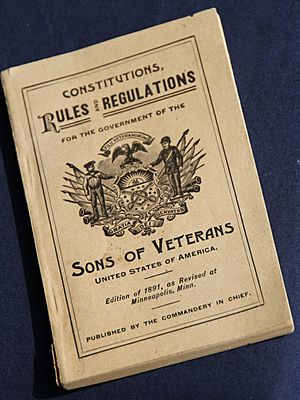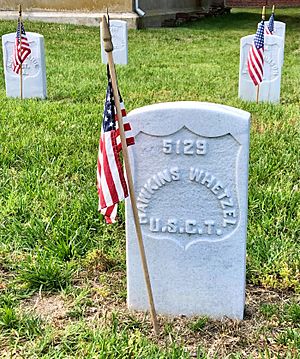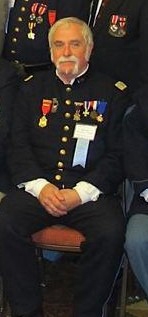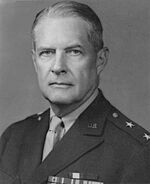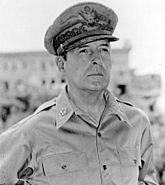Sons of Union Veterans of the Civil War facts for kids
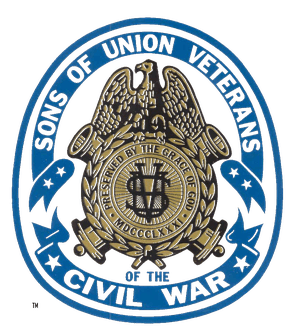 |
|
| Abbreviation | SUVCW |
|---|---|
| Predecessor | Grand Army of the Republic |
| Established | Organized November 12, 1881, chartered by Congress on August 20, 1954 |
| Type | Patriotic-Hereditary society |
| Legal status | Congressionally chartered non-profit corporation |
| Purpose | Historical, benevolent |
| Headquarters | Harrisburg, Pennsylvania |
|
Membership (2022)
|
6,574 |
|
Commander-in-Chief
|
Peter J. Hritsko |
|
Senior Vice Commander-in-Chief
|
Kevin L. Martin |
|
Junior Vice Commander-in-Chief
|
Kevin P. Tucker |
| Council of Administration | |
| Publication | The Banner |
|
Formerly called
|
Sons of Veterans of the United States of America |
The Sons of Union Veterans of the Civil War (SUVCW) is an American organization. It was created by the United States Congress. This group works to keep alive the history of soldiers who fought in the American Civil War. They also honor the memory of these brave veterans.
The SUVCW is the official follow-up group to the Grand Army of the Republic (GAR). The GAR was a very large and important group of Union Army veterans after the Civil War. Most of the SUVCW's activities happen at local community groups called "Camps." These Camps are part of bigger state or regional groups called "Departments." The main SUVCW office is in Harrisburg, Pennsylvania. It is located at the National Civil War Museum. Members of the SUVCW are called "Brothers." They meet once a year at a big event called the National Encampment.
The SUVCW and its smaller groups are also charitable organizations. This means they do good work and can receive tax-deductible donations.
Contents
History of the SUVCW
Starting in the 1800s
The SUVCW was first called the Sons of Veterans of the United States of America. Major Augustus P. Davis started it in November 1881. He wanted to make sure the ideas of the Grand Army of the Republic (GAR) lived on. He also wanted to help veterans. The group is based on ideas of friendship, helping others, and loyalty.
In 1877, Davis first suggested creating a group for the sons of GAR members. He proposed this idea in Pittsburgh, Pennsylvania. At first, his idea was not accepted. But Davis kept trying. In September 1881, the GAR members decided not to stand in his way. Davis wanted to organize the sons of GAR members like a military group. Their goals would be similar to the GAR's. They would also help GAR members. He thought only the oldest living son of a GAR member should join. He imagined a group that was friendly, patriotic, and charitable. It would also be a military reserve ready to help in times of war. Members wore military-style uniforms and practiced drills.
Major Davis believed the Sons of Veterans would become a great military group. He thought they would honor Union veterans and keep their stories alive. He also believed they would promote patriotism. If the country ever needed help, the Sons of Veterans would be ready to defend it. They would be inspired by their fathers' bravery.
The first meeting of the organization happened on November 12, 1881. It was held in Pittsburgh's Old City Hall. Davis gathered 11 boys. They agreed to his plans for the Sons of Veterans of Pennsylvania (SVPA). They chose their leaders. Davis officially registered the SVPA on December 28, 1881. The state of Pennsylvania approved it on January 12, 1882.
At the same time, another group was forming in eastern Pennsylvania. It was called the Philadelphia Sons of Veterans (PSV). The PSV started on September 29, 1878, in Philadelphia. Other groups like it also began in Pennsylvania, New Jersey, and New York.
In 1879, the Earp family started Sons of Veterans groups in other states. By 1880, these groups joined the PSV. The PSV soon formed a state-level organization.
On February 22, 1882, the PSV created a national organization. A month later, the SVPA changed its name. It became the Sons of Veterans of the United States of America (SV). This showed its growth across the country. Major Davis worked hard to expand the group. SV groups formed in many states. By July 4, 1882, a formal organization for Pennsylvania was needed. The Division of Pennsylvania was created. The first SV meeting was held in Pittsburgh.
The SV continued to grow quickly in 1882. By fall, a national organization was clearly needed. On October 18, 1882, the first SV National Encampment took place in Pittsburgh. Davis's plans for the group were accepted. By July 1, 1884, the organization had over 20,000 members. In July 1883, many PSV groups left that organization. They joined the SV instead.
By August 1886, all remaining PSV groups had joined the SV. This ended the PSV. The SV grew very fast. By 1890, it had over 145,000 members. At that time, the GAR had about 400,000 members.
The SV and the GAR had a somewhat tricky relationship. GAR members wanted a good group for their sons. But they believed GAR membership should only be for veterans. The GAR approved the SV, but it would not make the SV part of the GAR. On July 25, 1883, the GAR officially recognized the SV. They said the SV deserved the support of all GAR members. The GAR fully accepted the SV in 1888.
John P. Rea, a leader of the GAR, spoke about the future. He said the GAR would soon be too old to continue its work. He believed the Sons of Veterans could take over. He suggested the GAR should officially recognize the SV.
Because of Rea's speech, the GAR passed a resolution. It said the GAR supported the goals of the Sons of Veterans. It also recommended that GAR members help create new Sons of Veterans groups.
The 1900s
In 1903, the Sons of Veterans split into two parts. One part handled civilian tasks, and the other handled military training. A new group called the Sons of Veterans Reserve (SVR) was formed for military training. The SVR was not a state militia. So, it did not become part of the National Guard. Today, the SVR is the uniformed, ceremonial part of the SUVCW. Only active SUVCW members can join the SVR.
The number of SV members was highest in 1904. At that time, there were over 200,000 members. This happened during a time when many celebrations brought together white Civil War veterans.
In 1925, members chose the organization's current name: Sons of Union Veterans of the Civil War. Sons of veterans from other wars tried to join. But members decided that the SUVCW would only be for descendants of Civil War veterans.
On February 13, 1954, Albert Woolson was the last living member of the GAR. He gave all remaining GAR property to the SUVCW. He wanted the SUVCW to return the GAR records to the towns where the GAR groups were located. This way, the communities could use and benefit from them.
On August 20, 1954, the U.S. Congress passed a law. This law officially recognized the SUVCW with a special charter. Famous people who helped establish the SUVCW included General of the Army Douglas MacArthur. He was the son of Arthur MacArthur Jr., a Medal of Honor winner. Another was Major General Ulysses S. Grant III. He was the grandson of Ulysses S. Grant, the Civil War general and 18th U.S. President.
The 2000s
In early 2021, the SUVCW had 31 Departments. It also had over 240 local Camps. About 6,400 men were members. The group is led by a Commander-in-Chief. This leader is chosen every year at the National Encampment. The Commander-in-Chief works with the SUVCW Council of Administration. Together, they manage how the organization runs.
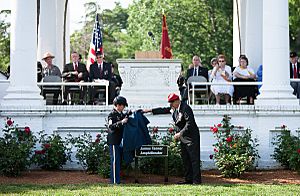
Because of the COVID-19 pandemic, the SUVCW held its first online National Encampment. This happened on October 24, 2020. This was done to keep members safe and healthy.
In 2017, the U.S. government gave the SUVCW tax-exempt status. This means that donations to the SUVCW are tax-deductible. It also means the SUVCW can receive gifts and inheritances without paying taxes.
The SUVCW was very active from 2011 to 2015. They took part in many events across the country and worldwide. These events celebrated the 150th anniversary of the Civil War.
Joining the SUVCW
Any man who is 14 years or older can become a full member of the SUVCW. Boys aged 6 to 14 can join as Junior members. To join, a man must meet these requirements:
1. He must be a direct descendant of a Soldier, Sailor, Marine, or member of the Revenue Cutter Service. This ancestor must have served honorably in the U.S. military during the Civil War (April 12, 1861, to April 9, 1865). Or, he can be a direct descendant of a brother, sister, half-brother, or half-sister of such a soldier.
2. He must never have been found guilty of a serious crime.
3. He, or his ancestor through whom he claims membership, must never have willingly fought against the United States government.
Men who do not have the right family history can become Associate members. They must show a real interest in the Civil War. They also need to agree to support the SUVCW's goals. Associate members must also meet the second and third rules listed above.
Other Groups Connected to SUVCW
The Auxiliary to the Sons of Union Veterans of the Civil War (ASUVCW) was formed in 1883. By 1894, it had its current name. Women can join if they are direct or indirect descendants of Civil War soldiers, sailors, or marines. Mothers, wives, widows, daughters, and adopted daughters of SUVCW members can also join. Women who do not have this family connection can become Associate members. They must be interested in the Civil War and support the Auxiliary's goals. Girls aged eight and older can join as Junior members.
Besides the SUVCW and ASUVCW, three other groups are part of the Allied Orders of the Grand Army of the Republic. These are:
- the Daughters of Union Veterans of the Civil War (DUVCW)
- the Ladies of the Grand Army of the Republic (LGAR)
- the Woman's Relief Corps (WRC)
See also
 In Spanish: Sons of Union Veterans of the Civil War para niños
In Spanish: Sons of Union Veterans of the Civil War para niños


